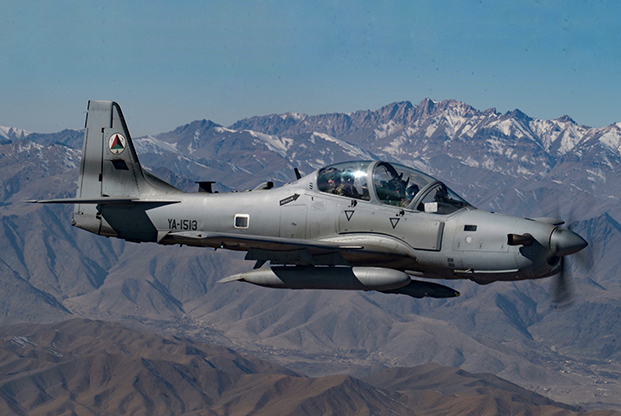
An Afghan pilot conducts training in an A-29 Super Tucano over Kabul, Afghanistan, as part of the Train Advise and Assist Command's (TAAC-Air) mission on Dec. 20, 2018. Air Force photo by SrA. Maygan Straight.
The Afghan Air Force is increasing capability and capacity for its strike platforms, which has “brought lots of change to the battlefield,” an Afghan pilot told Air Force Magazine.
Afghan A-29 Super Tucano pilots began dropping laser-guided bombs on March 22, 2018, and can now “do so very effectively,” Lt. Col. Gerald Ferdinand, commander of the 438th Air Expeditionary Advisory Squadron and lead A-29 adviser, said in a phone interview. That capability allowed them to train for night strikes since the tactics were already in place.
“We just had to add the new environment of doing those tactics at night,” Ferdinand explained.
An initial cadre of five Afghan pilots flew its first night combat mission on Dec. 8, and has since conducted 30 to 40 airstrikes over the course of about 20 missions.
The Taliban previously attacked most bases, compounds, and checkpoints after nightfall because the Afghan Air Force holds them at bay during the day, according to an Afghan pilot who led the cadre and asked not to be named for safety reasons.
“We were able to do a night mission successfully … that brought the [Afghan National Army], the Afghan troops’ morale really high,” and “also put lots of pressure on the enemy,” he told Air Force Magazine.
The precision offered by laser-guided bombs and the ability to strike at night means that “enemies know that they can hide anywhere, but not from A-29,” he said.
Two Afghan Air Force A-29s with four GBU-58 laser-guided munitions successfully executed the first deliberate Afghan Air Force A-29 strike on targets at night on Dec. 8, 2018. Video courtesy of the US Air Force.
The US Air Force has trained four more Afghan pilots in the Sierra Nevada Corp.-Embraer airframe since the first five became qualified to fly night missions, and now trains two to three aviators a month, Ferdinand said.
“We have a plan to continue to train the remaining pilots through the rest of the year,” he said, adding that he hopes all pilots will be ready to conduct night strikes by summer.
Right now, pilots fly combat missions at night for one week each month, plus another week of nighttime training. Airstrikes will increase as more pilots are trained, Ferdinand said.
Two Afghan Air Force A-29s with GBU-58 laser-guided munitions successfully executed their second deliberate Afghan Air Force strike on targets at night on Dec. 9, 2018. Video courtesy of the US Air Force.
While the A-29 enterprise matures, Afghan strike helicopters are gaining capacity as well. The MD-530 provides armed reconnaissance, escorts for aerial and ground missions, and overwatch for Afghan troops conducting sweeps, explained Maj. Cory Fale, the lead MD-530 advisor.
Because the MD-530s aren’t equipped with precision weapons, the pilots have to dive to attack, making night strikes less feasible, Fale said. “But the story for the MD-530 isn’t capability-driven, it’s capacity,” he noted.
In 2015, there were just a handful of the MD-530 helicopters, transitioning from a training helicopter to a weaponized version, Fale said. But “now we’ve almost doubled the helicopter fleet from where it was at the beginning of 2018 to where we’re at right now,” with more aircraft on the way. That means more pilots will need to move through a training pipeline that begins in the US and ends in Afghanistan.
Yet despite the expanded capacity and capability of each aircraft, Fale, who was in Afghanistan when the A-29 and MD-530 advising programs merged in 2016, said he is most impressed with the fact that both platforms—and the pilots—have fought in sustained combat for more than three years.
There is “no quick end in sight,” Fale said, but the pilots continue to show up and get the job done.